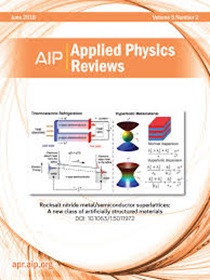基于无机半导体纳米结构的印刷光电探测器
IF 11.9
1区 物理与天体物理
Q1 PHYSICS, APPLIED
引用次数: 0
摘要
光电器件,如光电探测器(pd),在许多应用中都需要,包括高速光通信、机器人、医疗保健和仿生视觉系统,这些应用需要使用光进行检测和交互。因此,使用各种光敏材料和传统的微/纳米制造技术在平面衬底上制备了各种各样的pd。近年来,人们在开发具有灵活外形因素和使用环保材料和方法的pd方面付出了相当大的努力。这些努力导致了可降解材料和印刷电子产品的探索,作为一种资源高效的制造途径,并包含寿命结束问题。本文综述了这些新进展,特别关注基于无机(如晶体硅、化合物半导体、金属氧化物等)半导体纳米结构[如纳米线(NWs)、纳米带(NRs)等]的柔性pd。讨论了各种自下而上和自上而下实现纳米结构的方法的优缺点,以及在柔性基板上印刷纳米结构的湿式(可溶液加工)和干式印刷和组装方法,以及它们在各种应用中的适用性。本文的讨论得到了对印刷pd的关键性能指标的比较分析的支持,这些指标包括响应性、探测性、ILight/IDark比、响应速度和外部量子效率。这次全面的讨论有望使对印刷和柔性pd领域感兴趣的学术界和工业界的研究人员和从业人员受益。本文章由计算机程序翻译,如有差异,请以英文原文为准。
Inorganic semiconducting nanostructures-based printed photodetectors
Optoelectronic devices, such as photodetectors (PDs), are needed in many applications including high-speed optical communications, robotics, healthcare, and biomimetic visual systems, which require detection and interaction using light. As a result, a wide variety of PDs on planar substrates have been reported using various light sensitive materials and traditional micro-/nano-fabrication technologies. In recent years, considerable efforts have been devoted to developing PDs with flexible form factors and using eco-friendly materials and approaches. These efforts have resulted in exploration of degradable materials and printed electronics as a resource-efficient route for manufacturing and to contain end-of-life issues. This paper reviews such new advances, particularly focusing on flexible PDs based on inorganic (e.g., crystalline silicon, compound semiconductors, metal oxides, etc.) semiconductor nanostructures [e.g., Nanowires (NWs), Nanoribbons (NRs), etc.]. The advantages and disadvantages of various bottom-up and top-down methods explored to realize the nanostructures and the wet (solution-processable) and dry printing and assembly methods to print the nanostructures on flexible substrates, are discussed along with their suitability for various applications. This discussion is supported by a comparative analysis of printed PDs in terms of key performance metrics such as responsivity, detectivity, ILight/IDark ratio, response speed, and external quantum efficiency. This comprehensive discussion is expected to benefit researchers and practitioners from academia and industry interested in the field of printed and flexible PDs.
求助全文
通过发布文献求助,成功后即可免费获取论文全文。
去求助
来源期刊

Applied physics reviews
PHYSICS, APPLIED-
CiteScore
22.50
自引率
2.00%
发文量
113
审稿时长
2 months
期刊介绍:
Applied Physics Reviews (APR) is a journal featuring articles on critical topics in experimental or theoretical research in applied physics and applications of physics to other scientific and engineering branches. The publication includes two main types of articles:
Original Research: These articles report on high-quality, novel research studies that are of significant interest to the applied physics community.
Reviews: Review articles in APR can either be authoritative and comprehensive assessments of established areas of applied physics or short, timely reviews of recent advances in established fields or emerging areas of applied physics.
 求助内容:
求助内容: 应助结果提醒方式:
应助结果提醒方式:


